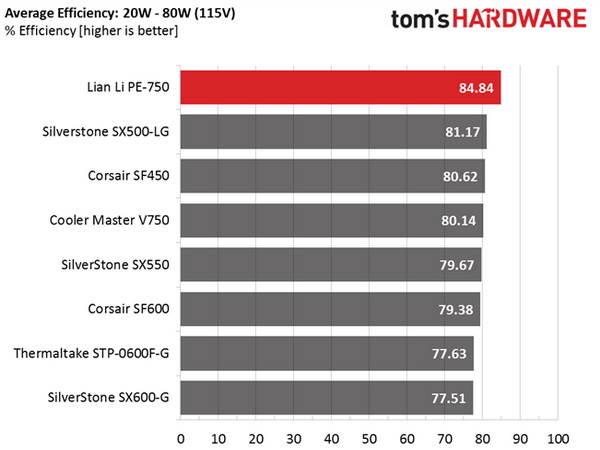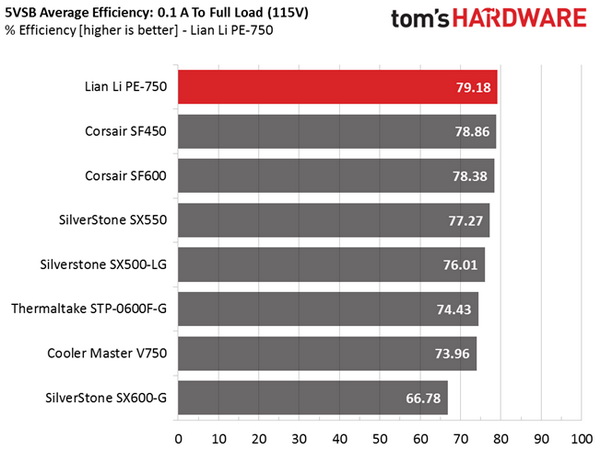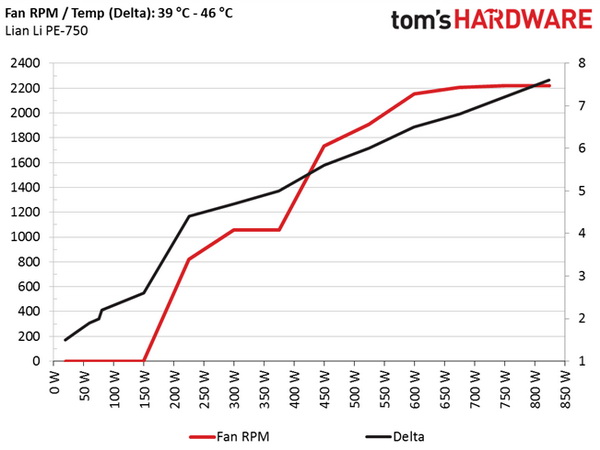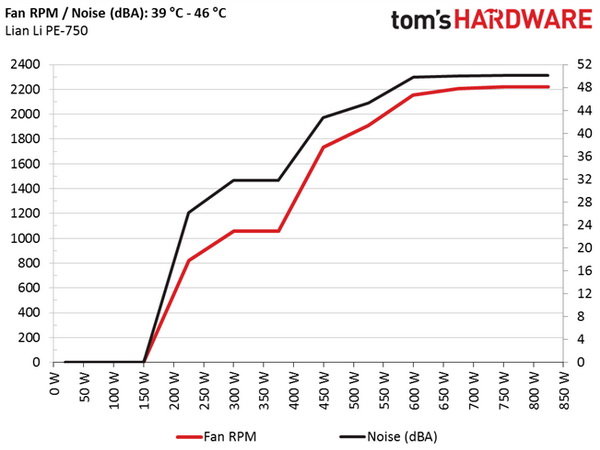Lian Li PE-750 SFX-L 750W PSU Review
Lian Li enters the PSU market again with two new SFX-L models featuring 550 W and 750 W capacities. The PE-750 is under the microscope today. It features modular cabling, a single +12V rail, and a semi-passive fan.
Why you can trust Tom's Hardware
Efficiency, Temperature, And Noise
Efficiency
Our efficiency testing procedure is detailed here.
Using results from the previous page, we plotted a chart showing the PE-750's efficiency at low loads, and loads from 10 to 110 percent of its maximum-rated capacity.




The PE-750's efficiency levels are impressively high under light and normal loads. This platform puts all of the other SFX and SFX-L designs we've tested to shame.
Efficiency At Low Loads
In the following tests, we measure the PE-750's efficiency at loads significantly lower than 10 percent of its maximum capacity (the lowest load the 80 PLUS standard measures). The loads we dialed were 20, 40, 60 and 80 W. This is important for representing when a PC is idle, with power-saving features turned on.
| Test # | 12V | 5V | 3.3V | 5VSB | DC/AC (Watts) | Efficiency | Fan Speed | Fan Noise | PF/AC Volts |
|---|---|---|---|---|---|---|---|---|---|
| 1 | 1.220A | 0.481A | 0.475A | 0.194A | 19.58 | 76.91% | 0 RPM | 0 dB(A) | 0.828 |
| 11.921V | 5.107V | 3.350V | 5.100V | 25.46 | 115.1V | ||||
| 2 | 2.472A | 0.970A | 0.984A | 0.390A | 39.69 | 83.75% | 0 RPM | 0 dB(A) | 0.898 |
| 11.919V | 5.104V | 3.346V | 5.094V | 47.39 | 115.1V | ||||
| 3 | 3.725A | 1.464A | 1.495A | 5.089A | 59.83 | 87.41% | 0 RPM | 0 dB(A) | 0.927 |
| 11.917V | 5.102V | 3.341V | 5.089V | 68.45 | 115.1V | ||||
| 4 | 4.961A | 1.964A | 1.975A | 0.784A | 79.74 | 91.29% | 0 RPM | 0 dB(A) | 0.938 |
| 11.923V | 5.099V | 3.338V | 5.081V | 87.35 | 115.1V |
Efficiency under light loads is very high, and noise output is zero thanks to a semi-passive operating mode. We couldn't ask for more from a Platinum-rated SFX-L power supply.
5VSB Efficiency
The ATX specification states that 5VSB standby supply efficiency should be as high as possible, recommending 50 percent or higher efficiency with 100 mA of load, 60 percent or higher with 250 mA of load, and 70 percent or higher with 1 A or more of load.
We take four measurements: one each at 100, 250 and 1000 mA, and one with the full load the 5VSB rail can handle.
Get Tom's Hardware's best news and in-depth reviews, straight to your inbox.
| Test # | 5VSB | DC/AC (Watts) | Efficiency | PF/AC Volts |
|---|---|---|---|---|
| 1 | 0.101A | 0.50 | 73.53% | 0.058 |
| 4.929V | 0.68 | 115.2V | ||
| 2 | 0.251A | 1.24 | 78.48% | 0.127 |
| 4.923V | 1.58 | 115.2V | ||
| 3 | 1.002A | 4.90 | 83.33% | 0.318 |
| 4.894V | 5.88 | 115.2V | ||
| 4 | 2.501A | 12.09 | 81.36% | 0.433 |
| 4.836V | 14.86 | 115.2V |


The 5VSB rail is highly efficient as well. Enhance does a good job here.
Power Consumption In Idle And Standby
In the table below, you'll find the power consumption and voltage values of all rails (except -12V) when the PSU is idle (powered on, but without any load on its rails), and the power consumption when the PSU is in standby mode (without any load, at 5VSB).
| Mode | 12V | 5V | 3.3V | 5VSB | Watts | PF/AC Volts |
|---|---|---|---|---|---|---|
| Idle | 11.937V | 5.111V | 3.352V | 5.111V | 1.66 | 0.135 |
| 115.2V | ||||||
| Standby | 0.07 | 0.006 | ||||
| 115.2V |


Phantom power is way lower than the ErP Lot 6 2013 directive's requirements.
Fan RPM, Delta Temperature And Output Noise
Our mixed noise testing is described in detail here.
The first chart below illustrates the cooling fan's speed (in RPM), and the delta between input and output temperature. The results were obtained at 39 °C (102.2 °F) to 46 °C (114.8 °F) ambient temperature.
The next chart shows the cooling fan's speed (again, in RPM) and output noise. We measured acoustics from one meter away, inside a small, custom-made anechoic chamber with internals completely covered in sound-proofing material (be quiet! Noise Absorber kit). Background noise inside the chamber was below 18 dB(A) during testing, and the results were obtained with the PSU operating at 39 °C (102.2 °F) to 46 °C (114.8 °F) ambient temperature.
The following graph illustrates the fan's output noise over the PSU's operating range. The same conditions of the above graph apply to our measurements, though the ambient temperature was between at 28 °C (82.4 °F) to 30 °C (86 °F).
Passive operation lasts up to around 120 W of load. Afterwards, the fan spins slowly up to 500 W. With more than 500 W, its speed increases significantly. Beyond 680 W, the noise exceeds 43 dB(A). If you don't plan on pushing this power supply hard, expect it to run quietly. Otherwise, it can get loud.
Current page: Efficiency, Temperature, And Noise
Prev Page Load Regulation, Hold-Up Time, And Inrush Current Next Page Protection Features, Evaluated
Aris Mpitziopoulos is a contributing editor at Tom's Hardware, covering PSUs.
-
Aris_Mp For the SFX-L standards actually it is quite good. There is next to zero competition in this field. With a few part changes this platform has potential, however I don't know if it could keep efficiency at the same high levels.Reply -
shrapnel_indie Lian Li is supposed to be a premium brand. Just look how expensive (and the usual quality of) their cases are when you can find them. By the numbers and its internals, this doesn't look like a premium brand product, regardless of how much or how little competition they got in a given market.Reply
Lian Li, have you decided to no longer be a true premium brand? -
Valantar Definitely disappointing. Looks like Lian Li is going for the "money to burn, don't care" market. This PSU had amazing promise, but the choice of fan, the too-small caps and the short warranty make this unbuyable. Now, I don't have empirical data to base this on, but I'd guess most people springing $160 on a PSU - SFX or not - want it to last more than 2-3 years. And using a fan that's both short-lived _and_ unsuitable for horizontal mounting? That's just idiotic.Reply -
Virtual_Singularity Solid review, as always, great job Aris. Even if this isn't an ideal psu, Lian Li is a quality brand, a quality case brand. However, its worth noting that of the ample (edit: particularly sfx/sfxl) PSU's Enhance has OEM'd for various brands, this one has to be among the best of them. Even if Lian Li introduced an absolutely horrible psu, wouldn't matter much to their fans, its the quality they put into many of their cases that's most important. Even if they cave more than they already have to the recent case trends, I hope they still keep producing no nonsense cases for that niche market that still values them.Reply -
Valantar Reply18666014 said:Solid review, as always, great job Aris. Even if this isn't an ideal psu, Lian Li is a quality brand, a quality case brand. However, its worth noting that of the ample PSU's Enhance has OEM'd for various brands, this one has to be among the best of them. Even if Lian Li introduced an absolutely horrible psu, wouldn't matter much to their fans, its the quality they put into many of their cases that's most important. Even if they cave more than they already have to the recent case trends, I hope they still keep producing no nonsense cases for that niche market that still values them.
Sure, Lian Li makes great cases (although IMHO they too often screw up their nice minimalist looks with unnecessary clutter, and they're way behind the times in a few usability/ease of build areas today). But how does this relate to this PSU? In no way at all. Lian Li might be "a quality brand, a quality case brand", but that does nothing to change the fact that this is a premium priced PSU built with mind-boggling cost cutting in key areas, making its lifetime radically shorter than it should be. This would barely be okay for a $60 PSU. For a $160 unit, it's not only a deal breaker, it's about on the same level as the engineers shouting "F*ck you!" to every individual buyer. -
Virtual_Singularity Reply18670375 said:18666014 said:Solid review, as always, great job Aris. Even if this isn't an ideal psu, Lian Li is a quality brand, a quality case brand. However, its worth noting that of the ample PSU's Enhance has OEM'd for various brands, this one has to be among the best of them. Even if Lian Li introduced an absolutely horrible psu, wouldn't matter much to their fans, its the quality they put into many of their cases that's most important. Even if they cave more than they already have to the recent case trends, I hope they still keep producing no nonsense cases for that niche market that still values them.
Sure, Lian Li makes great cases (although IMHO they too often screw up their nice minimalist looks with unnecessary clutter, and they're way behind the times in a few usability/ease of build areas today). But how does this relate to this PSU? In no way at all. Lian Li might be "a quality brand, a quality case brand", but that does nothing to change the fact that this is a premium priced PSU built with mind-boggling cost cutting in key areas, making its lifetime radically shorter than it should be. This would barely be okay for a $60 PSU. For a $160 unit, it's not only a deal breaker, it's about on the same level as the engineers shouting "F*ck you!" to every individual buyer.
Fwiw, I've no need of this form factor in a psu, so I'm really not bothered by it so much. But take the comment Aris made above into account. TBH, it'd be very easy to come to your conclusion if not for this psu being in the SFXL category. It really is one of the better ones I've seen reviewed, despite the short warranty. A shorter warranty is typical of the latest comparable units, (Silverstone, for example, has 2-3 years depending on location) the exception being Corsair, possibly. I say possibly because I don't know how their latest sfx units, despite having a longer warranty, compare with this one in overall efficiency, performance. and size.
The latest platinum/titanium rated SFX/SFX-L units carry a price premium. For those demanding a sfx-l unit, the one reviewed above is among the best performers, regardless of it's short warranty. -
blazorthon Problem is that it has multiple issues that are not inherent of being a smaller form factor such as SFX. Lian Li could have simply used a better, same-sized fan. There is also enough room for better caps. Being expensive just because of its efficiency with no regard for long-term reliability is idiotic and contradictory to being a high-end PSU in the first place.Reply -
gadgety Great to highlight the weaknesses of this PSU. How does it compare to the Silverstone SX700-LPT? Which one is best. Do a shootout, or do an comparison piece.Reply


